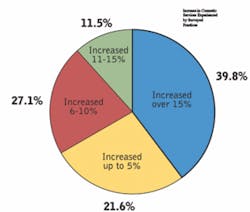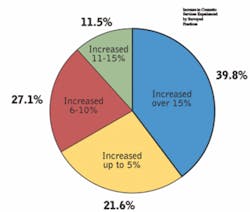Cosmetic Dentistry
We had lots of questions regarding COSMETIC DENTISTRY. Then we found the answer.
Could a perfect storm be emerging for cosmetic dentistry? Or has it already arrived? Think of the factors that recently have converged to increase awareness of cosmetic dentistry:
➠The popularity of extreme makeover shows
➠The growing use of at-home whitening products fueled by multi-million-dollar ad campaigns
➠Millions of aging baby boomers who want to look and feel younger
➠The public’s obsession with lifestyles of celebrities
➠The success of dental spas
In 2004, the American Academy of Cosmetic Dentistry commissioned Baltimore-based Levin Group, Inc. to conduct a survey called The State of Cosmetic Dentistry. Results released by the AACD confirm that cosmetic dentistry will continue to be a growth sector for many practices. Cosmetic production, on average, has grown by 12.5 percent during the past five years, with some doctors experiencing close to a 40 percent increase. The majority of dentists (79 percent) expect similar or better growth during the next five years.
• About the survey
Levin Group developed the survey, sent a detailed questionnaire to dentists (AACD members and non-members) across the country, and then tabulated and interpreted the responses. The 26-question survey provides data about the current state of cosmetic dentistry and the growing role cosmetic procedures will play in the future of dentistry.
“This survey confirms our observations that cosmetic dentistry has experienced tremendous growth in recent years,” says Dr. Nicholas Davis, AACD president. “The responses also indicate that many practices are positioning themselves for the continued growth in cosmetic procedures during the next five years. This heightened interest in cosmetic dentistry has been a catalyst for doctors and technicians seeking to improve their skills and knowledge as reflected in the 57 percent increase in AACD membership since 2000.”
• Cosmetic patients
The most common age groups to inquire about cosmetic dentistry were adults 31 to 40 years old (38 percent) and baby boomers ages 41 to 50 (32 percent). The young adults of Generation X (ages 21 to 30) edged their senior counterparts ages 51 to 60 by a slight margin, 14 percent to 12 percent for a distant third, according to feedback from surveyed doctors.
While it is not surprising that 31- to 50-year-old patients are more interested in cosmetic dentistry than younger or older patients, most patients - no matter their age - rarely initiated inquiries about esthetic services. In fact, fewer than 10 percent of patients asked about these options. In the majority of cases, doctors or hygienists, not patients, introduced the concept. This data indicates that practices must do more to promote cosmetic dentistry through internal educational efforts including brochures, posters, and scripting. In consulting to Levin Group PracticesTM, we found that training entire teams - not just hygienists - on practice services and case presentation can significantly increase esthetic procedures.
Of patients who inquire about cosmetic dentistry, doctors find that 96 percent are female. Because of this disparity between males and females in requesting cosmetic dentistry, practices should focus on specific strategies to educate men about esthetic services. One strategy is to ask male cosmetic patients for testimonials. Posting before-and-after photographs of male cosmetic patients is another way to begin a dialog about esthetic procedures and increase case acceptance from this largely untapped source of potential cosmetic production.
The dentist is the primary patient educator in 49 percent of the practices polled. This statistic identifies an opportunity to promote the hygienist as an initiator of patient dialogues. Better training for hygienists will enable them to gain more confidence when presenting possible treatment options to patients.
• Cosmetic services
Whitening was the most requested cosmetic service by patients at 29 percent, yet it ranked near the bottom of all services performed by surveyed dentists at 7 percent. Doctors said one-fourth of the services performed in their practices were strictly preventive. The most popular procedure performed by participants was placing crowns and bridges, which occurred 24 percent of the time in surveyed practices. In the survey, crowns and bridges outpaced such cosmetic procedures as direct bonding (19 percent), onlays-inlays (7 percent), whitening (7 percent), and veneers (4 percent).
This result brings up a question about the nature of cosmetic dentistry. Should crowns and bridges be considered cosmetic procedures, or do they fall more into the preventive category as a traditional treatment for missing teeth? Under most definitions supplied by dentists, crowns and bridges would be considered cosmetic procedures because they enhance a patient’s appearance.
• What exactly is cosmetic dentistry?
The American Dental Association has not formally defined cosmetic dentistry. Most survey respondents were happy to provide their interpretation of what cosmetic dentistry means to them and their dental practices. Generally speaking, participants described cosmetic dentistry as a method intended to improve a patient’s smile, self-image, or both.
Nevertheless, as often is the case with large groups, respondents emphasized different aspects of cosmetic dentistry in their definitions. These elements included functional improvements, utilization of specific dental materials and techniques, lifestyle enhancements, elective procedures, and the art and science of dentistry, among others. A selection of definitions for cosmetic dentistry follows:
➤Functional improvements -
✓ Improvement in appearance by reshaping and redefining tooth shape, size, and position
✓ Enhancing a patient’s smile with proper shape, color, and harmony of all teeth together
➤Emphasis on materials, techniques, or both -
✓ The esthetic enhancement of an individual’s teeth through restorative or whitening techniques or both
✓ Using tooth-colored materials and techniques to create a natural look for the patient
➤Focus on lifestyle enhancements -
✓ Making someone more huggable and kissable and able to laugh with more confidence
✓ Enhancing self-esteem by making people look and feel better about themselves
➤Cosmetic dentistry = elective dentistry -
✓ All dentistry should have cosmetic results, but true cosmetic dentistry is elective, done purely to enhance one’s smile - an out-of-pocket expense.
✓ Elective dentistry makes teeth more attractive
➤Art and science emphasis -
✓ The art and science of improving the quality of life and giving the best smile for the patient
✓ Prefer “esthetic” - the art and science of returning teeth, smile, or both to “natural” beauty
• Education, location, presentation
The survey touched on doctor education, office location, and case-presentation skills. To further their knowledge of cosmetic dentistry and expand the services they offer, many dentists are attending continuing education. About 40 percent of dentists surveyed took 21 or more hours of CE courses in the clinical aspects of cosmetic dentistry; in addition, more than half took up to five hours of CE courses in the management aspects of cosmetics.
Office location seems to have some effect on cosmetic dentistry growth. Urban and suburban offices are much more likely to have experienced large growth in this area of dentistry, but dentists in all types of geographic areas think their patients view cosmetic dentistry positively. Almost one-third of the doctors estimate that patients seeking cosmetic services spend more than $600 a year on esthetic procedures.
During case presentation, doctors who offer cosmetic services are finding that concerns about cost, appearance, and longevity of results are foremost in patients’ minds. To foster greater case acceptance, dentists are emphasizing patient education and open communication along with offering third-party financing. Doctors responding to the survey - more than half of whom have practiced 20 years or more - expressed enthusiasm about the future growth of cosmetic dentistry, with 98 percent of the doctors believing that the growth rate will increase or remain constant during the next five years.
• Conclusion
The State of Cosmetic Dentistry survey provides useful data about cosmetic dentists, procedures, and patients.
“The survey highlights some areas of opportunity for dentists and their teams,” Dr. Davis says. “These include enhancing case-presentation skills and doing more to target male patients. We at AACD are pleased with this substantial amount of data gathered by Levin Group in compiling this survey. Dentists can use the survey as a benchmark to drive future performance.”
Like most doctors surveyed, I am optimistic that cosmetic dentistry will continue to increase dramatically during the next five years. Dentists who want to provide these services to their patients and profit from increased production must continue to take CE classes and train their teams to present more cosmetic dentistry.
To download the survey, go to the AACD Web site, www.aacd.com, click “online press kit,” and select “press releases.” For more information about cosmetic dentistry, reach the AACD at (608) 222-8583 or e-mail [email protected].
Roger P. Levin, DDS, MBA, is founder and CEO of Levin Group Inc., a leading dental-management consulting firm specializing in implementing documented business systems into dental practices. Levin Group can be reached at (888) 973-0000 or at www.levingroup.com.

